Korean Air's International Business: Analysis of Strategies & Growth
VerifiedAdded on 2023/06/14
|16
|3798
|472
Report
AI Summary
This report provides an in-depth analysis of Korean Air's international business operations. It begins with an introduction to the company, including its background, fleet, destinations, and revenue over the past five years. The report explores the reasons behind Korean Air's internationalization, the benefits derived from it, and the application of the international product lifecycle theory with relevant examples. It also examines the external environment faced by the company in the host country (Singapore), focusing on economic, technological, and environmental factors. Furthermore, the report discusses the company's international staffing strategies and organizational structure, highlighting the advantages and disadvantages of the chosen structure. Finally, it presents examples demonstrating how Korean Air implements customized and standardized systems in its host country, showcasing its adaptability and strategic alignment with local market conditions.
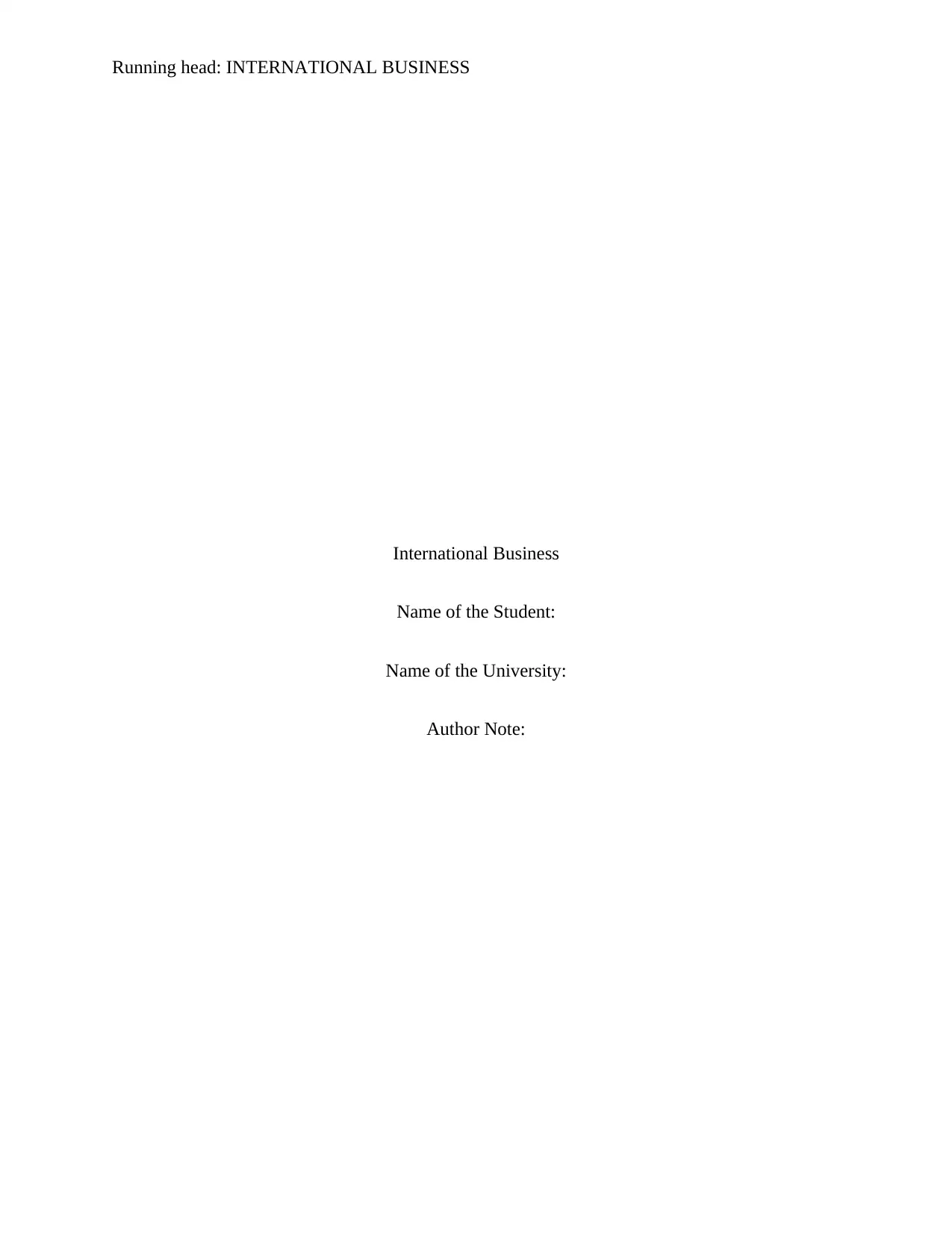
Running head: INTERNATIONAL BUSINESS
International Business
Name of the Student:
Name of the University:
Author Note:
International Business
Name of the Student:
Name of the University:
Author Note:
Paraphrase This Document
Need a fresh take? Get an instant paraphrase of this document with our AI Paraphraser
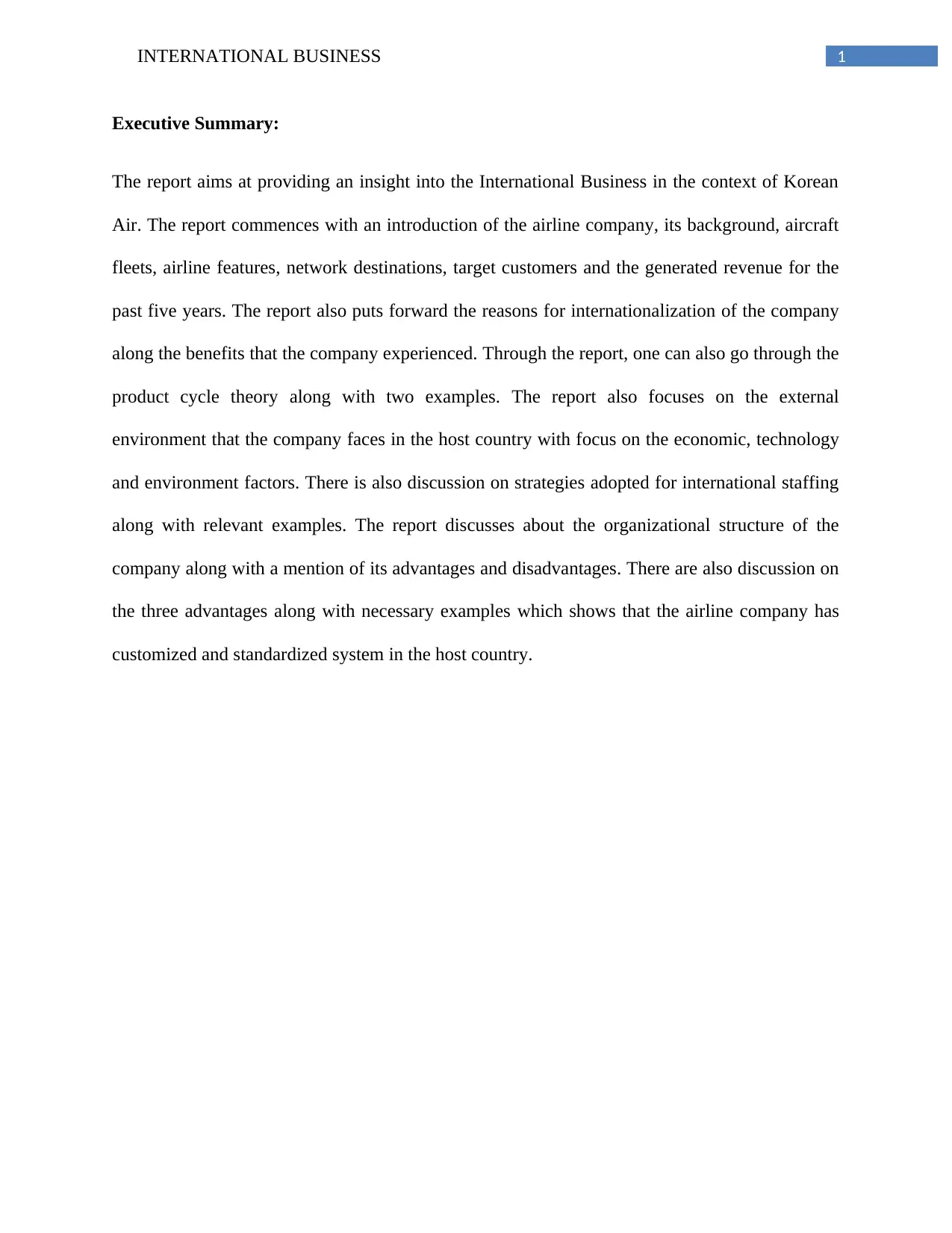
1INTERNATIONAL BUSINESS
Executive Summary:
The report aims at providing an insight into the International Business in the context of Korean
Air. The report commences with an introduction of the airline company, its background, aircraft
fleets, airline features, network destinations, target customers and the generated revenue for the
past five years. The report also puts forward the reasons for internationalization of the company
along the benefits that the company experienced. Through the report, one can also go through the
product cycle theory along with two examples. The report also focuses on the external
environment that the company faces in the host country with focus on the economic, technology
and environment factors. There is also discussion on strategies adopted for international staffing
along with relevant examples. The report discusses about the organizational structure of the
company along with a mention of its advantages and disadvantages. There are also discussion on
the three advantages along with necessary examples which shows that the airline company has
customized and standardized system in the host country.
Executive Summary:
The report aims at providing an insight into the International Business in the context of Korean
Air. The report commences with an introduction of the airline company, its background, aircraft
fleets, airline features, network destinations, target customers and the generated revenue for the
past five years. The report also puts forward the reasons for internationalization of the company
along the benefits that the company experienced. Through the report, one can also go through the
product cycle theory along with two examples. The report also focuses on the external
environment that the company faces in the host country with focus on the economic, technology
and environment factors. There is also discussion on strategies adopted for international staffing
along with relevant examples. The report discusses about the organizational structure of the
company along with a mention of its advantages and disadvantages. There are also discussion on
the three advantages along with necessary examples which shows that the airline company has
customized and standardized system in the host country.
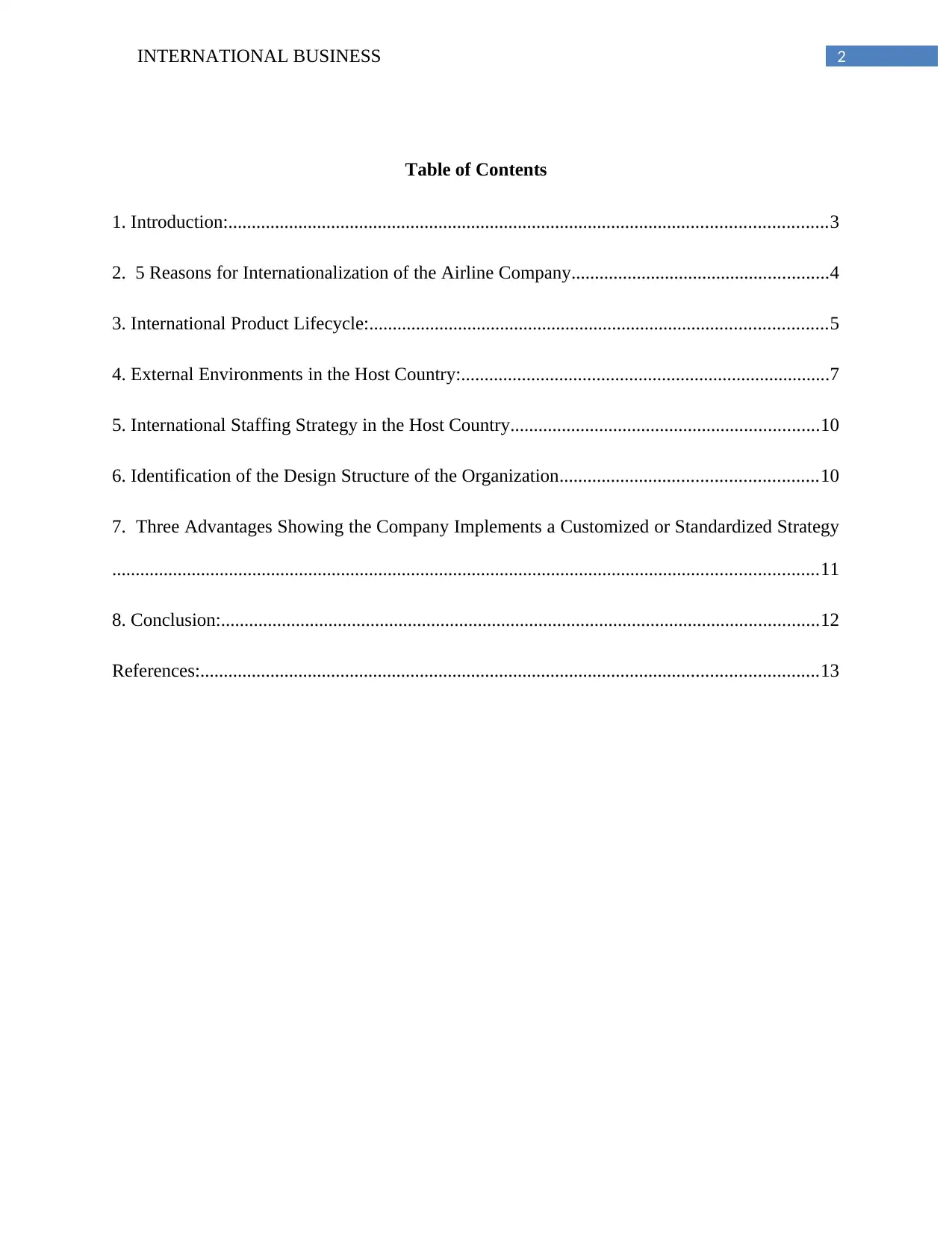
2INTERNATIONAL BUSINESS
Table of Contents
1. Introduction:................................................................................................................................3
2. 5 Reasons for Internationalization of the Airline Company.......................................................4
3. International Product Lifecycle:..................................................................................................5
4. External Environments in the Host Country:...............................................................................7
5. International Staffing Strategy in the Host Country..................................................................10
6. Identification of the Design Structure of the Organization.......................................................10
7. Three Advantages Showing the Company Implements a Customized or Standardized Strategy
.......................................................................................................................................................11
8. Conclusion:................................................................................................................................12
References:....................................................................................................................................13
Table of Contents
1. Introduction:................................................................................................................................3
2. 5 Reasons for Internationalization of the Airline Company.......................................................4
3. International Product Lifecycle:..................................................................................................5
4. External Environments in the Host Country:...............................................................................7
5. International Staffing Strategy in the Host Country..................................................................10
6. Identification of the Design Structure of the Organization.......................................................10
7. Three Advantages Showing the Company Implements a Customized or Standardized Strategy
.......................................................................................................................................................11
8. Conclusion:................................................................................................................................12
References:....................................................................................................................................13
⊘ This is a preview!⊘
Do you want full access?
Subscribe today to unlock all pages.

Trusted by 1+ million students worldwide
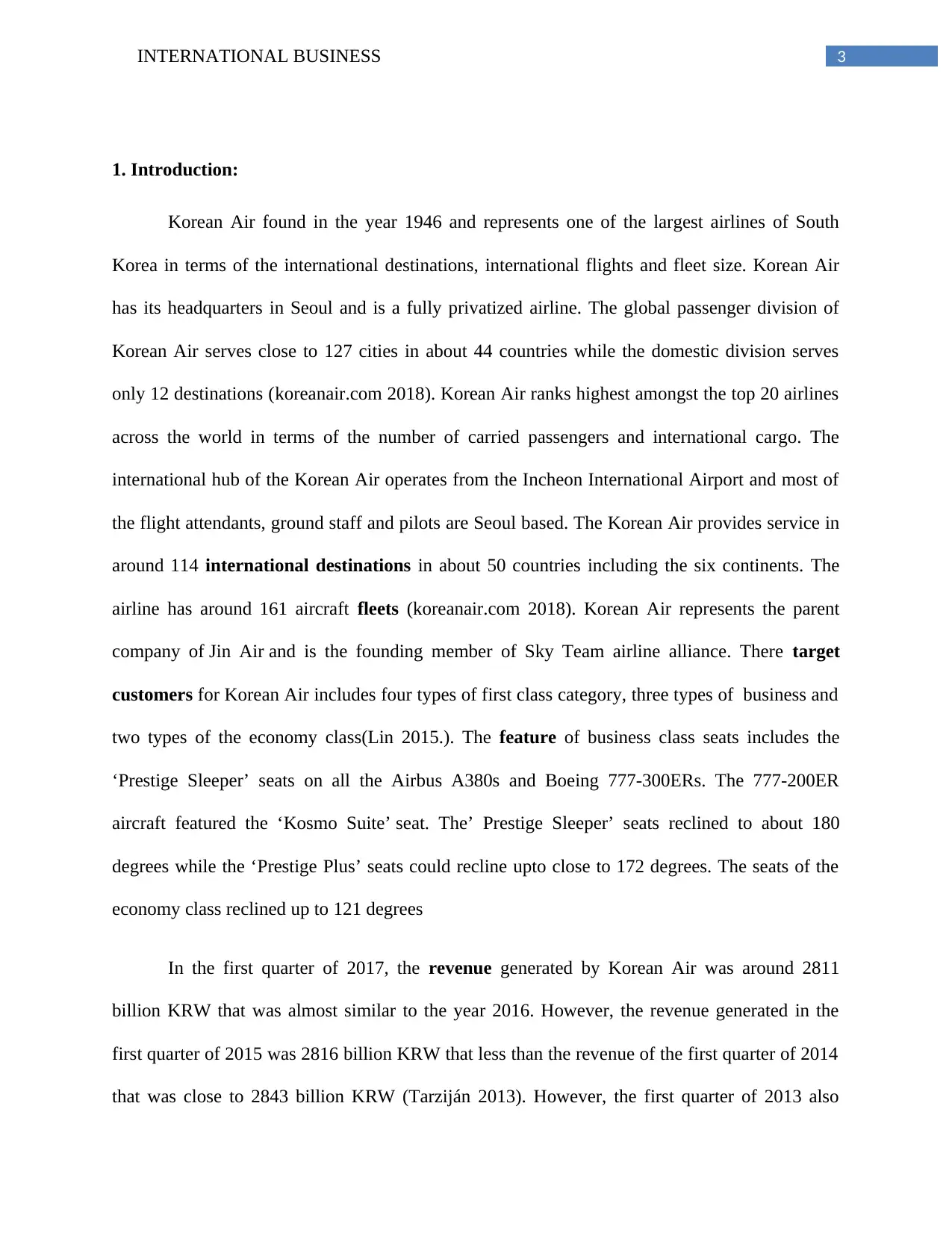
3INTERNATIONAL BUSINESS
1. Introduction:
Korean Air found in the year 1946 and represents one of the largest airlines of South
Korea in terms of the international destinations, international flights and fleet size. Korean Air
has its headquarters in Seoul and is a fully privatized airline. The global passenger division of
Korean Air serves close to 127 cities in about 44 countries while the domestic division serves
only 12 destinations (koreanair.com 2018). Korean Air ranks highest amongst the top 20 airlines
across the world in terms of the number of carried passengers and international cargo. The
international hub of the Korean Air operates from the Incheon International Airport and most of
the flight attendants, ground staff and pilots are Seoul based. The Korean Air provides service in
around 114 international destinations in about 50 countries including the six continents. The
airline has around 161 aircraft fleets (koreanair.com 2018). Korean Air represents the parent
company of Jin Air and is the founding member of Sky Team airline alliance. There target
customers for Korean Air includes four types of first class category, three types of business and
two types of the economy class(Lin 2015.). The feature of business class seats includes the
‘Prestige Sleeper’ seats on all the Airbus A380s and Boeing 777-300ERs. The 777-200ER
aircraft featured the ‘Kosmo Suite’ seat. The’ Prestige Sleeper’ seats reclined to about 180
degrees while the ‘Prestige Plus’ seats could recline upto close to 172 degrees. The seats of the
economy class reclined up to 121 degrees
In the first quarter of 2017, the revenue generated by Korean Air was around 2811
billion KRW that was almost similar to the year 2016. However, the revenue generated in the
first quarter of 2015 was 2816 billion KRW that less than the revenue of the first quarter of 2014
that was close to 2843 billion KRW (Tarziján 2013). However, the first quarter of 2013 also
1. Introduction:
Korean Air found in the year 1946 and represents one of the largest airlines of South
Korea in terms of the international destinations, international flights and fleet size. Korean Air
has its headquarters in Seoul and is a fully privatized airline. The global passenger division of
Korean Air serves close to 127 cities in about 44 countries while the domestic division serves
only 12 destinations (koreanair.com 2018). Korean Air ranks highest amongst the top 20 airlines
across the world in terms of the number of carried passengers and international cargo. The
international hub of the Korean Air operates from the Incheon International Airport and most of
the flight attendants, ground staff and pilots are Seoul based. The Korean Air provides service in
around 114 international destinations in about 50 countries including the six continents. The
airline has around 161 aircraft fleets (koreanair.com 2018). Korean Air represents the parent
company of Jin Air and is the founding member of Sky Team airline alliance. There target
customers for Korean Air includes four types of first class category, three types of business and
two types of the economy class(Lin 2015.). The feature of business class seats includes the
‘Prestige Sleeper’ seats on all the Airbus A380s and Boeing 777-300ERs. The 777-200ER
aircraft featured the ‘Kosmo Suite’ seat. The’ Prestige Sleeper’ seats reclined to about 180
degrees while the ‘Prestige Plus’ seats could recline upto close to 172 degrees. The seats of the
economy class reclined up to 121 degrees
In the first quarter of 2017, the revenue generated by Korean Air was around 2811
billion KRW that was almost similar to the year 2016. However, the revenue generated in the
first quarter of 2015 was 2816 billion KRW that less than the revenue of the first quarter of 2014
that was close to 2843 billion KRW (Tarziján 2013). However, the first quarter of 2013 also
Paraphrase This Document
Need a fresh take? Get an instant paraphrase of this document with our AI Paraphraser
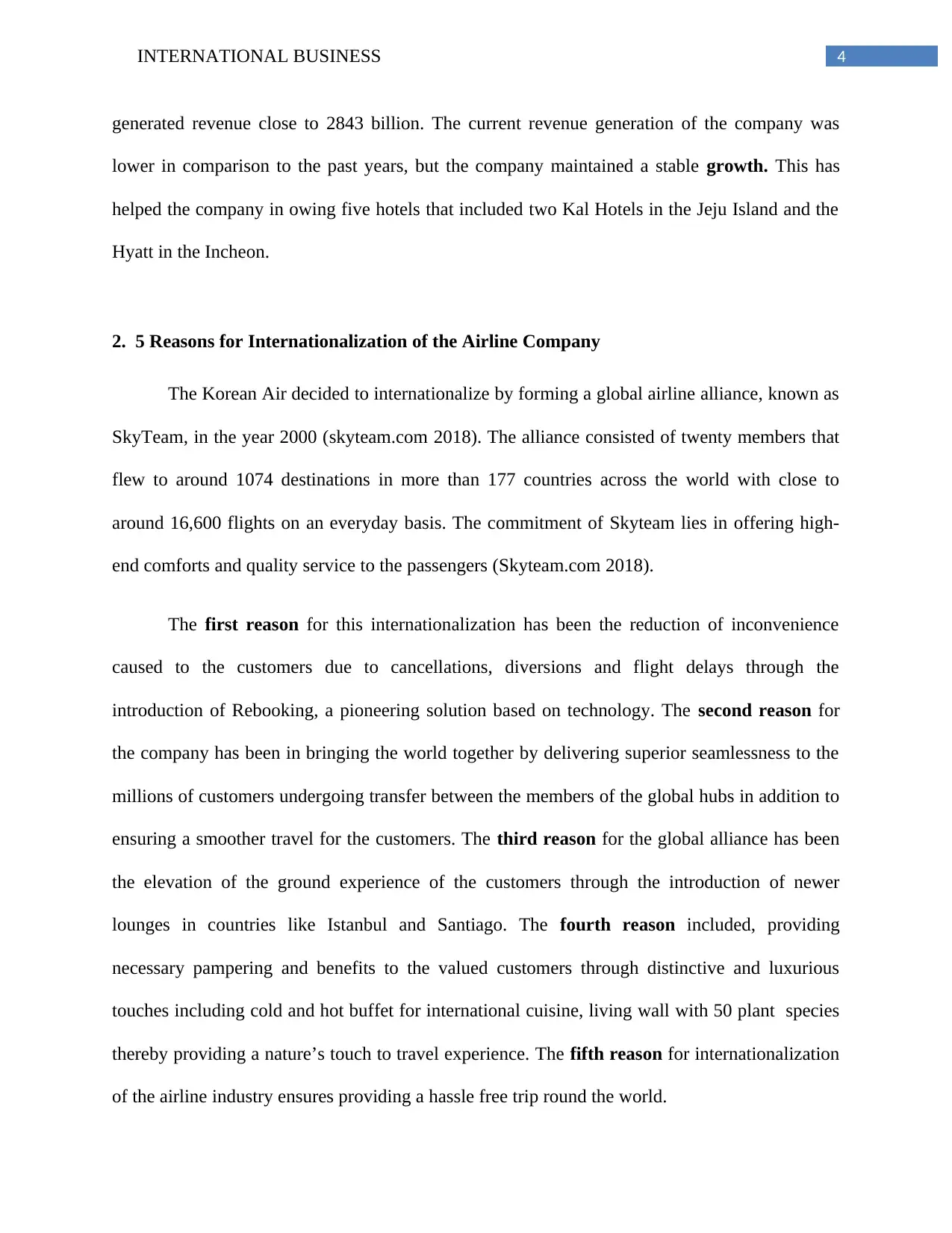
4INTERNATIONAL BUSINESS
generated revenue close to 2843 billion. The current revenue generation of the company was
lower in comparison to the past years, but the company maintained a stable growth. This has
helped the company in owing five hotels that included two Kal Hotels in the Jeju Island and the
Hyatt in the Incheon.
2. 5 Reasons for Internationalization of the Airline Company
The Korean Air decided to internationalize by forming a global airline alliance, known as
SkyTeam, in the year 2000 (skyteam.com 2018). The alliance consisted of twenty members that
flew to around 1074 destinations in more than 177 countries across the world with close to
around 16,600 flights on an everyday basis. The commitment of Skyteam lies in offering high-
end comforts and quality service to the passengers (Skyteam.com 2018).
The first reason for this internationalization has been the reduction of inconvenience
caused to the customers due to cancellations, diversions and flight delays through the
introduction of Rebooking, a pioneering solution based on technology. The second reason for
the company has been in bringing the world together by delivering superior seamlessness to the
millions of customers undergoing transfer between the members of the global hubs in addition to
ensuring a smoother travel for the customers. The third reason for the global alliance has been
the elevation of the ground experience of the customers through the introduction of newer
lounges in countries like Istanbul and Santiago. The fourth reason included, providing
necessary pampering and benefits to the valued customers through distinctive and luxurious
touches including cold and hot buffet for international cuisine, living wall with 50 plant species
thereby providing a nature’s touch to travel experience. The fifth reason for internationalization
of the airline industry ensures providing a hassle free trip round the world.
generated revenue close to 2843 billion. The current revenue generation of the company was
lower in comparison to the past years, but the company maintained a stable growth. This has
helped the company in owing five hotels that included two Kal Hotels in the Jeju Island and the
Hyatt in the Incheon.
2. 5 Reasons for Internationalization of the Airline Company
The Korean Air decided to internationalize by forming a global airline alliance, known as
SkyTeam, in the year 2000 (skyteam.com 2018). The alliance consisted of twenty members that
flew to around 1074 destinations in more than 177 countries across the world with close to
around 16,600 flights on an everyday basis. The commitment of Skyteam lies in offering high-
end comforts and quality service to the passengers (Skyteam.com 2018).
The first reason for this internationalization has been the reduction of inconvenience
caused to the customers due to cancellations, diversions and flight delays through the
introduction of Rebooking, a pioneering solution based on technology. The second reason for
the company has been in bringing the world together by delivering superior seamlessness to the
millions of customers undergoing transfer between the members of the global hubs in addition to
ensuring a smoother travel for the customers. The third reason for the global alliance has been
the elevation of the ground experience of the customers through the introduction of newer
lounges in countries like Istanbul and Santiago. The fourth reason included, providing
necessary pampering and benefits to the valued customers through distinctive and luxurious
touches including cold and hot buffet for international cuisine, living wall with 50 plant species
thereby providing a nature’s touch to travel experience. The fifth reason for internationalization
of the airline industry ensures providing a hassle free trip round the world.

5INTERNATIONAL BUSINESS
The benefits of internationalization experienced by the company include (Lee, Lee and
Choi 2014):
1. Ensures Creation of New Revenue Potential: Internationalization helps the company
in getting greater access to a larger customer base and helps in generating more revenue
2. Ensuring Exposure to the Foreign Investment Opportunities: Globalization also
helps the company in earning foreign investment that is extremely valuable for the business.
3. Helps in Improving the Reputation of the Company: Going global and marketing
their offerings to a different population helps the airline company in earning prestige for
themselves.
3. International Product Lifecycle:
The International product life cycle model ensures dividing the product marketing into
main four stages that includes introduction, maturity, growth, and decline. When the product life
cycle solely depends on the sales volume then its introduction and growth stage is merged (Bilir
2014). However, for the products with internationally availability the remaining three stages
include the impacts of the foreign production and outsourcing. On the other hand, the rapid
growth of the product in the home market often leads to experiencing saturation when the
countries with lower wage tries to imitate it and thereby ensures flooding international market.
General Theory
The introduction of a product in a specific country, leads to rapid growth in the sales
volume as the market demand remain unsatisfied. With more people wanting to buy the product,
The benefits of internationalization experienced by the company include (Lee, Lee and
Choi 2014):
1. Ensures Creation of New Revenue Potential: Internationalization helps the company
in getting greater access to a larger customer base and helps in generating more revenue
2. Ensuring Exposure to the Foreign Investment Opportunities: Globalization also
helps the company in earning foreign investment that is extremely valuable for the business.
3. Helps in Improving the Reputation of the Company: Going global and marketing
their offerings to a different population helps the airline company in earning prestige for
themselves.
3. International Product Lifecycle:
The International product life cycle model ensures dividing the product marketing into
main four stages that includes introduction, maturity, growth, and decline. When the product life
cycle solely depends on the sales volume then its introduction and growth stage is merged (Bilir
2014). However, for the products with internationally availability the remaining three stages
include the impacts of the foreign production and outsourcing. On the other hand, the rapid
growth of the product in the home market often leads to experiencing saturation when the
countries with lower wage tries to imitate it and thereby ensures flooding international market.
General Theory
The introduction of a product in a specific country, leads to rapid growth in the sales
volume as the market demand remain unsatisfied. With more people wanting to buy the product,
⊘ This is a preview!⊘
Do you want full access?
Subscribe today to unlock all pages.

Trusted by 1+ million students worldwide
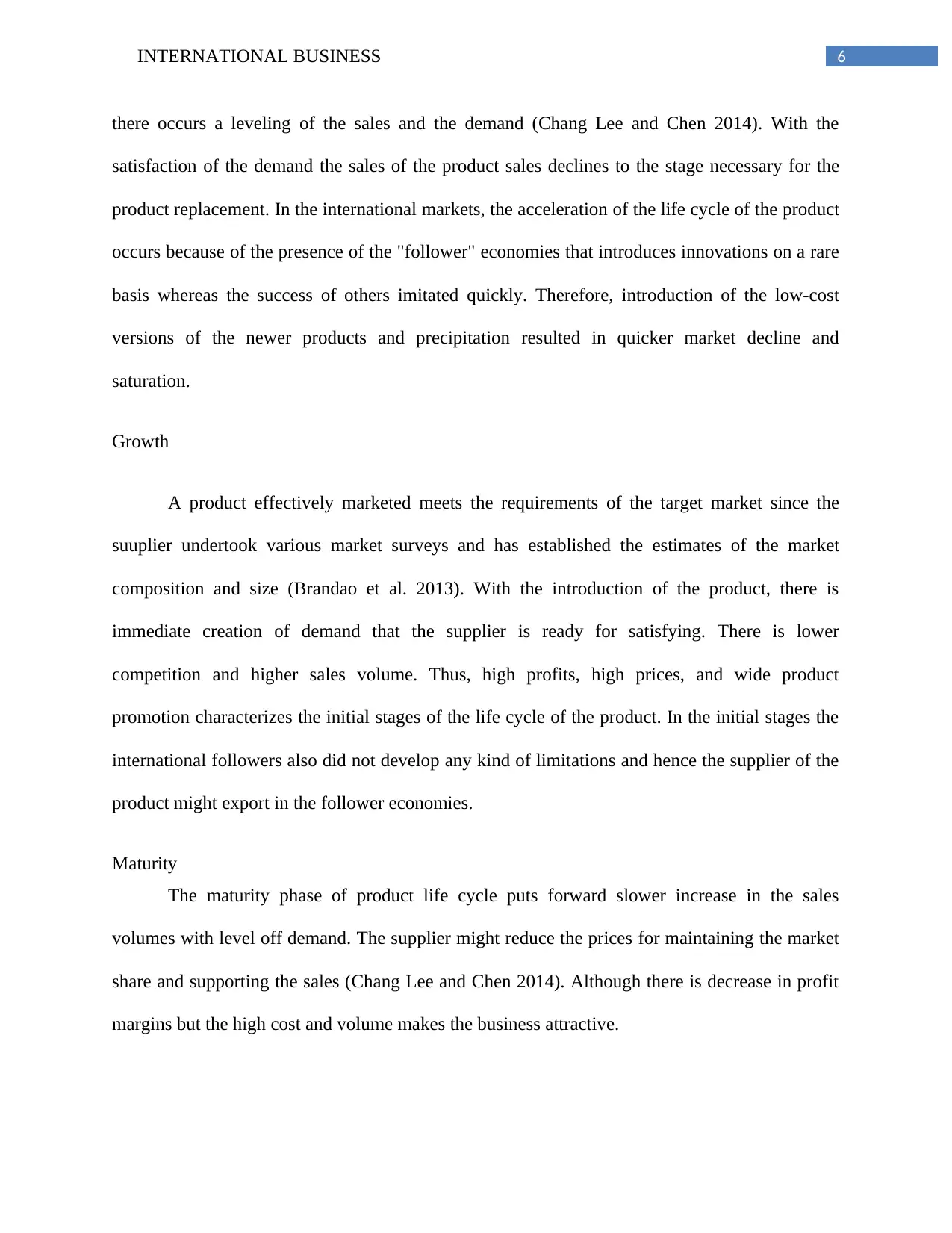
6INTERNATIONAL BUSINESS
there occurs a leveling of the sales and the demand (Chang Lee and Chen 2014). With the
satisfaction of the demand the sales of the product sales declines to the stage necessary for the
product replacement. In the international markets, the acceleration of the life cycle of the product
occurs because of the presence of the "follower" economies that introduces innovations on a rare
basis whereas the success of others imitated quickly. Therefore, introduction of the low-cost
versions of the newer products and precipitation resulted in quicker market decline and
saturation.
Growth
A product effectively marketed meets the requirements of the target market since the
suuplier undertook various market surveys and has established the estimates of the market
composition and size (Brandao et al. 2013). With the introduction of the product, there is
immediate creation of demand that the supplier is ready for satisfying. There is lower
competition and higher sales volume. Thus, high profits, high prices, and wide product
promotion characterizes the initial stages of the life cycle of the product. In the initial stages the
international followers also did not develop any kind of limitations and hence the supplier of the
product might export in the follower economies.
Maturity
The maturity phase of product life cycle puts forward slower increase in the sales
volumes with level off demand. The supplier might reduce the prices for maintaining the market
share and supporting the sales (Chang Lee and Chen 2014). Although there is decrease in profit
margins but the high cost and volume makes the business attractive.
there occurs a leveling of the sales and the demand (Chang Lee and Chen 2014). With the
satisfaction of the demand the sales of the product sales declines to the stage necessary for the
product replacement. In the international markets, the acceleration of the life cycle of the product
occurs because of the presence of the "follower" economies that introduces innovations on a rare
basis whereas the success of others imitated quickly. Therefore, introduction of the low-cost
versions of the newer products and precipitation resulted in quicker market decline and
saturation.
Growth
A product effectively marketed meets the requirements of the target market since the
suuplier undertook various market surveys and has established the estimates of the market
composition and size (Brandao et al. 2013). With the introduction of the product, there is
immediate creation of demand that the supplier is ready for satisfying. There is lower
competition and higher sales volume. Thus, high profits, high prices, and wide product
promotion characterizes the initial stages of the life cycle of the product. In the initial stages the
international followers also did not develop any kind of limitations and hence the supplier of the
product might export in the follower economies.
Maturity
The maturity phase of product life cycle puts forward slower increase in the sales
volumes with level off demand. The supplier might reduce the prices for maintaining the market
share and supporting the sales (Chang Lee and Chen 2014). Although there is decrease in profit
margins but the high cost and volume makes the business attractive.
Paraphrase This Document
Need a fresh take? Get an instant paraphrase of this document with our AI Paraphraser
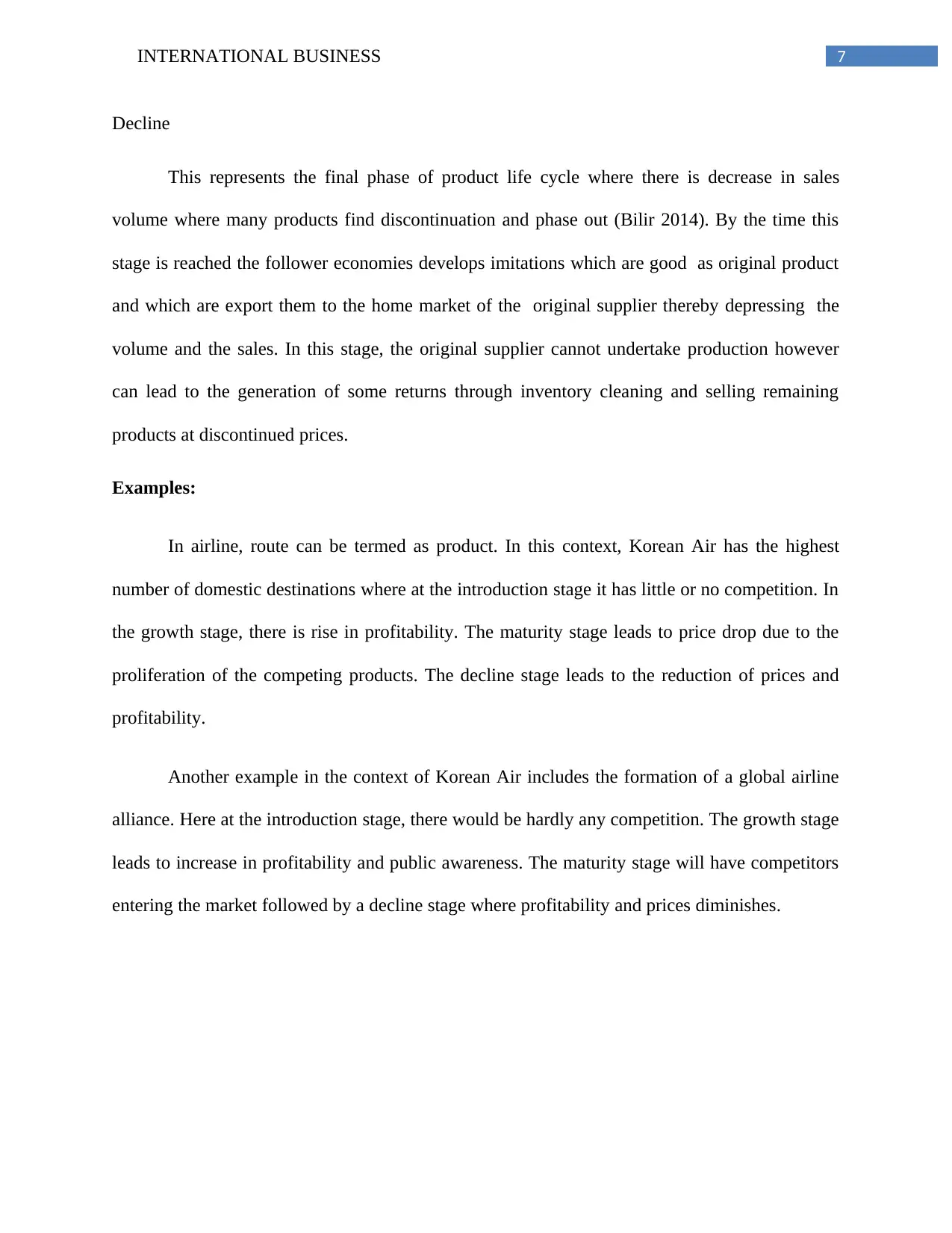
7INTERNATIONAL BUSINESS
Decline
This represents the final phase of product life cycle where there is decrease in sales
volume where many products find discontinuation and phase out (Bilir 2014). By the time this
stage is reached the follower economies develops imitations which are good as original product
and which are export them to the home market of the original supplier thereby depressing the
volume and the sales. In this stage, the original supplier cannot undertake production however
can lead to the generation of some returns through inventory cleaning and selling remaining
products at discontinued prices.
Examples:
In airline, route can be termed as product. In this context, Korean Air has the highest
number of domestic destinations where at the introduction stage it has little or no competition. In
the growth stage, there is rise in profitability. The maturity stage leads to price drop due to the
proliferation of the competing products. The decline stage leads to the reduction of prices and
profitability.
Another example in the context of Korean Air includes the formation of a global airline
alliance. Here at the introduction stage, there would be hardly any competition. The growth stage
leads to increase in profitability and public awareness. The maturity stage will have competitors
entering the market followed by a decline stage where profitability and prices diminishes.
Decline
This represents the final phase of product life cycle where there is decrease in sales
volume where many products find discontinuation and phase out (Bilir 2014). By the time this
stage is reached the follower economies develops imitations which are good as original product
and which are export them to the home market of the original supplier thereby depressing the
volume and the sales. In this stage, the original supplier cannot undertake production however
can lead to the generation of some returns through inventory cleaning and selling remaining
products at discontinued prices.
Examples:
In airline, route can be termed as product. In this context, Korean Air has the highest
number of domestic destinations where at the introduction stage it has little or no competition. In
the growth stage, there is rise in profitability. The maturity stage leads to price drop due to the
proliferation of the competing products. The decline stage leads to the reduction of prices and
profitability.
Another example in the context of Korean Air includes the formation of a global airline
alliance. Here at the introduction stage, there would be hardly any competition. The growth stage
leads to increase in profitability and public awareness. The maturity stage will have competitors
entering the market followed by a decline stage where profitability and prices diminishes.

8INTERNATIONAL BUSINESS
4. External Environments in the Host Country:
Let the host country be Singapore. Therefore, the external environment faced by the
company in the host country in terms of economic, technological and environmental factors are
as follows:
Economic
Exchange rate: The economy of the Singapore faces higher degree of openness where
the country remains highly dependable on the international trade. On a domestic note, Singapore
does not experience changes against the value of the Singaporean currency. In spite of the fact
that Singapore Dollar (SGD) fluctuates constantly against the other currencies of the world the
prices of the imported products remains unchanged (Bussière, Delle and Peltonen 2014). For
example, the exchange rate of Singaporean dollar is paid much attention while planning for
overseas trip as a stronger SGD have a direct impact of as results in reduction of the prices of the
tickets of the airline company.
Petrol Prices:
As per the Global Petrol Prices, the petrol prices in Singapore stood at an average of
about S$2.01 during the last week of February 2017 that is higher by S$1.96 in the month of
January 2017 and close to S$1.91 during the month of November 2016 (Valadkhani 2013). For
example, although prices seem to increase but they represent historically lower values compared
to the year 2013 and 2015 when the petrol price stood at S$ 2.55 per litre. This will act as
attractive option for the airline company and contribute to its profitability.
Inflation Rate:
4. External Environments in the Host Country:
Let the host country be Singapore. Therefore, the external environment faced by the
company in the host country in terms of economic, technological and environmental factors are
as follows:
Economic
Exchange rate: The economy of the Singapore faces higher degree of openness where
the country remains highly dependable on the international trade. On a domestic note, Singapore
does not experience changes against the value of the Singaporean currency. In spite of the fact
that Singapore Dollar (SGD) fluctuates constantly against the other currencies of the world the
prices of the imported products remains unchanged (Bussière, Delle and Peltonen 2014). For
example, the exchange rate of Singaporean dollar is paid much attention while planning for
overseas trip as a stronger SGD have a direct impact of as results in reduction of the prices of the
tickets of the airline company.
Petrol Prices:
As per the Global Petrol Prices, the petrol prices in Singapore stood at an average of
about S$2.01 during the last week of February 2017 that is higher by S$1.96 in the month of
January 2017 and close to S$1.91 during the month of November 2016 (Valadkhani 2013). For
example, although prices seem to increase but they represent historically lower values compared
to the year 2013 and 2015 when the petrol price stood at S$ 2.55 per litre. This will act as
attractive option for the airline company and contribute to its profitability.
Inflation Rate:
⊘ This is a preview!⊘
Do you want full access?
Subscribe today to unlock all pages.

Trusted by 1+ million students worldwide

9INTERNATIONAL BUSINESS
The stronger dollar of Singapore makes the imports cheaper. The imports are
comparatively cheaper and hence the Singaporeans will spend lesser money on the foreign goods
and services there by hampering the profitability (Chow, Lim and McNelis 2014). For instance,
a weaker currency will result in higher inflation rate thereby leading to a rise in the interest rate.
This will lead to slowing down of the economy.
Technology:
Advanced:
Singapore faces rapid development in how the consumers, the businesses and the
industries are engaging with the technology because of constant technological innovation and the
Smart Nation initiative plans of the local government (Zhang 2013). The Smart Nation initiative
represents an effort for bringing together the various Singaporean economies for utilizing
technology with the aim of improving the lives of the people and creating better opportunities.
For example, there is evolvement of the business landscape due to increased penetration of IT,
advances in digitization and mobile. This positioning will help in attracting newer businesses
from the overseas and encourage the local organizations in seeing the importance of the weaving
technology.
Skilled Man Power or Processes:
Singapore has a skilled work force who understands big data and analytics and how to
advance the industries and business (Teng 2014). For example, they possess qualities like
practices, principles, concepts, assurance, planning and leadership. They also possess deeper
knowledge regarding the best practices revolving around Cyber security. In addition, they also
have the diverse set of skills for managing the threats and opportunities.
The stronger dollar of Singapore makes the imports cheaper. The imports are
comparatively cheaper and hence the Singaporeans will spend lesser money on the foreign goods
and services there by hampering the profitability (Chow, Lim and McNelis 2014). For instance,
a weaker currency will result in higher inflation rate thereby leading to a rise in the interest rate.
This will lead to slowing down of the economy.
Technology:
Advanced:
Singapore faces rapid development in how the consumers, the businesses and the
industries are engaging with the technology because of constant technological innovation and the
Smart Nation initiative plans of the local government (Zhang 2013). The Smart Nation initiative
represents an effort for bringing together the various Singaporean economies for utilizing
technology with the aim of improving the lives of the people and creating better opportunities.
For example, there is evolvement of the business landscape due to increased penetration of IT,
advances in digitization and mobile. This positioning will help in attracting newer businesses
from the overseas and encourage the local organizations in seeing the importance of the weaving
technology.
Skilled Man Power or Processes:
Singapore has a skilled work force who understands big data and analytics and how to
advance the industries and business (Teng 2014). For example, they possess qualities like
practices, principles, concepts, assurance, planning and leadership. They also possess deeper
knowledge regarding the best practices revolving around Cyber security. In addition, they also
have the diverse set of skills for managing the threats and opportunities.
Paraphrase This Document
Need a fresh take? Get an instant paraphrase of this document with our AI Paraphraser

10INTERNATIONAL BUSINESS
Environmental Factors:
The pollution created through transportation remains one of the vital problems in the
urban areas of Singapore. Singapore was amongst the countries that had the highest level of
emissions of industrial carbon dioxide (Sarooghi, Libaers and Burkemper 2015). The primary
concerns for Singaporeans are that the country does not possess enough water for supporting
their needs. Moreover, the pollution from the industrial byproducts such as oil enhances the
problem. Thus, water gets recycled after desalination
5. International Staffing Strategy in the Host Country
The company adopts a hiring strategy in the host country since it involves lesser
expense in terms of both moving expenses and training. However, there might be certain
expenses that might be less obvious which implies that the staffs might be more productive from
the beginning (Shams and Huisman 2016). For example, the hiring of the staffs of the host
country reduces the cost of the visas. Another strategy for involving the staffs of the host
country represents that they does not have any cultural challenges to face. For example, these
staffs are already familiar with the laws and the culture.
6. Identification of the Design Structure of the Organization
The Korean Air has a mixed organizational structure with mixed functions and
divisions. The airline company has lots of division according to the functions performed (Blau
2017). They have different divisions each for passenger and cargo. Since Korean Air is an
international company, so it also has a separate department for the international affairs. The
airline also has a Cabin Service aimed at training the flight attendants and providing higher
Environmental Factors:
The pollution created through transportation remains one of the vital problems in the
urban areas of Singapore. Singapore was amongst the countries that had the highest level of
emissions of industrial carbon dioxide (Sarooghi, Libaers and Burkemper 2015). The primary
concerns for Singaporeans are that the country does not possess enough water for supporting
their needs. Moreover, the pollution from the industrial byproducts such as oil enhances the
problem. Thus, water gets recycled after desalination
5. International Staffing Strategy in the Host Country
The company adopts a hiring strategy in the host country since it involves lesser
expense in terms of both moving expenses and training. However, there might be certain
expenses that might be less obvious which implies that the staffs might be more productive from
the beginning (Shams and Huisman 2016). For example, the hiring of the staffs of the host
country reduces the cost of the visas. Another strategy for involving the staffs of the host
country represents that they does not have any cultural challenges to face. For example, these
staffs are already familiar with the laws and the culture.
6. Identification of the Design Structure of the Organization
The Korean Air has a mixed organizational structure with mixed functions and
divisions. The airline company has lots of division according to the functions performed (Blau
2017). They have different divisions each for passenger and cargo. Since Korean Air is an
international company, so it also has a separate department for the international affairs. The
airline also has a Cabin Service aimed at training the flight attendants and providing higher
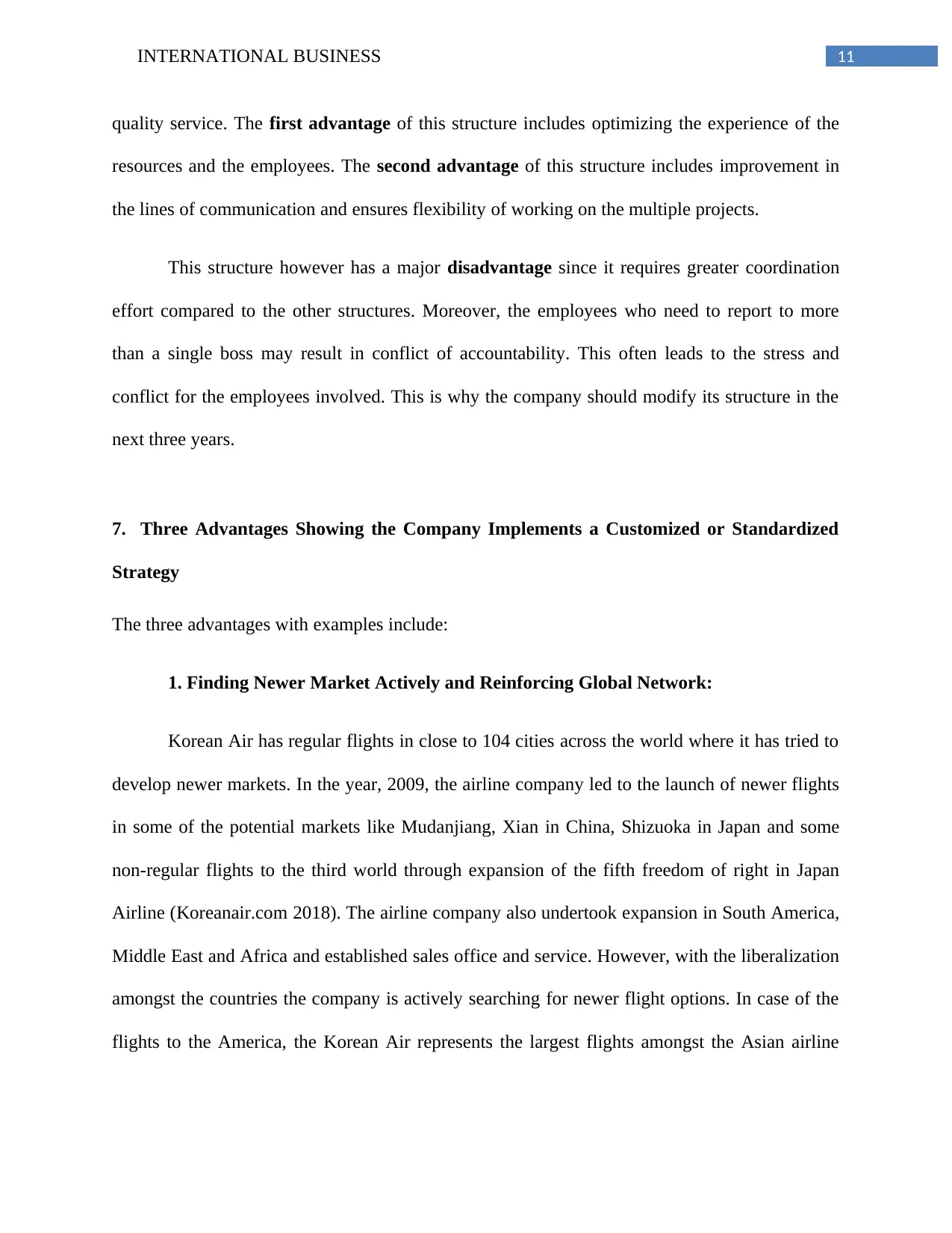
11INTERNATIONAL BUSINESS
quality service. The first advantage of this structure includes optimizing the experience of the
resources and the employees. The second advantage of this structure includes improvement in
the lines of communication and ensures flexibility of working on the multiple projects.
This structure however has a major disadvantage since it requires greater coordination
effort compared to the other structures. Moreover, the employees who need to report to more
than a single boss may result in conflict of accountability. This often leads to the stress and
conflict for the employees involved. This is why the company should modify its structure in the
next three years.
7. Three Advantages Showing the Company Implements a Customized or Standardized
Strategy
The three advantages with examples include:
1. Finding Newer Market Actively and Reinforcing Global Network:
Korean Air has regular flights in close to 104 cities across the world where it has tried to
develop newer markets. In the year, 2009, the airline company led to the launch of newer flights
in some of the potential markets like Mudanjiang, Xian in China, Shizuoka in Japan and some
non-regular flights to the third world through expansion of the fifth freedom of right in Japan
Airline (Koreanair.com 2018). The airline company also undertook expansion in South America,
Middle East and Africa and established sales office and service. However, with the liberalization
amongst the countries the company is actively searching for newer flight options. In case of the
flights to the America, the Korean Air represents the largest flights amongst the Asian airline
quality service. The first advantage of this structure includes optimizing the experience of the
resources and the employees. The second advantage of this structure includes improvement in
the lines of communication and ensures flexibility of working on the multiple projects.
This structure however has a major disadvantage since it requires greater coordination
effort compared to the other structures. Moreover, the employees who need to report to more
than a single boss may result in conflict of accountability. This often leads to the stress and
conflict for the employees involved. This is why the company should modify its structure in the
next three years.
7. Three Advantages Showing the Company Implements a Customized or Standardized
Strategy
The three advantages with examples include:
1. Finding Newer Market Actively and Reinforcing Global Network:
Korean Air has regular flights in close to 104 cities across the world where it has tried to
develop newer markets. In the year, 2009, the airline company led to the launch of newer flights
in some of the potential markets like Mudanjiang, Xian in China, Shizuoka in Japan and some
non-regular flights to the third world through expansion of the fifth freedom of right in Japan
Airline (Koreanair.com 2018). The airline company also undertook expansion in South America,
Middle East and Africa and established sales office and service. However, with the liberalization
amongst the countries the company is actively searching for newer flight options. In case of the
flights to the America, the Korean Air represents the largest flights amongst the Asian airline
⊘ This is a preview!⊘
Do you want full access?
Subscribe today to unlock all pages.

Trusted by 1+ million students worldwide
1 out of 16
Related Documents
Your All-in-One AI-Powered Toolkit for Academic Success.
+13062052269
info@desklib.com
Available 24*7 on WhatsApp / Email
![[object Object]](/_next/static/media/star-bottom.7253800d.svg)
Unlock your academic potential
Copyright © 2020–2025 A2Z Services. All Rights Reserved. Developed and managed by ZUCOL.





